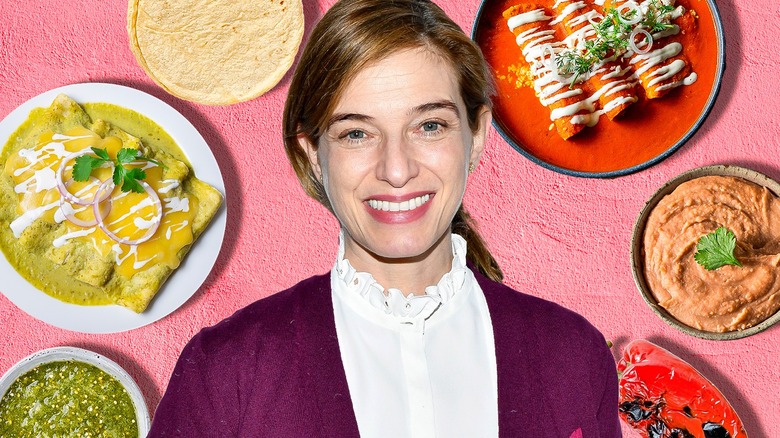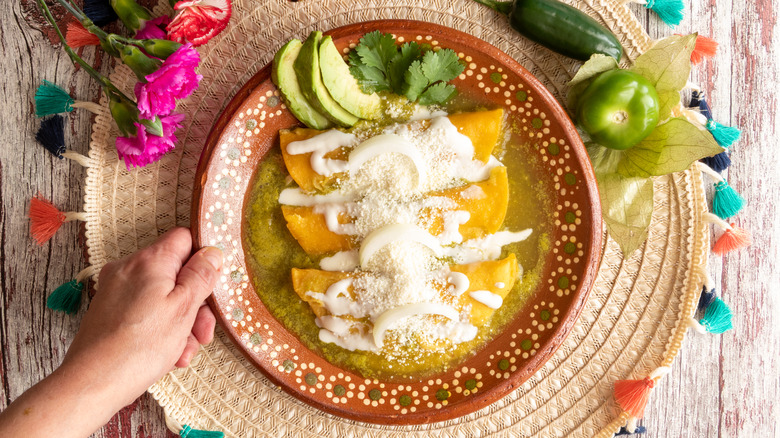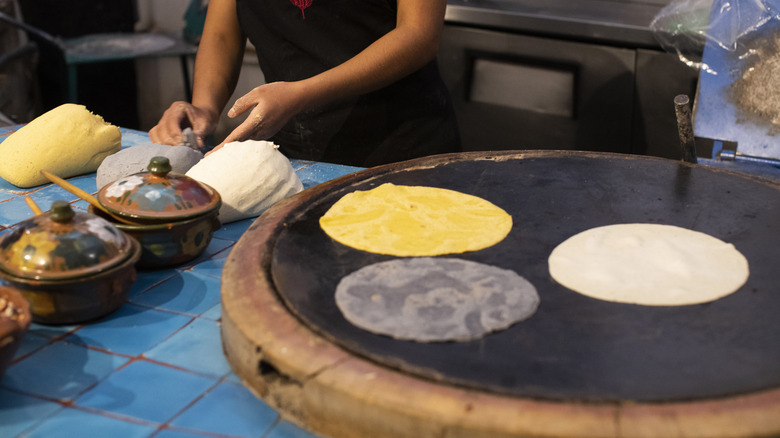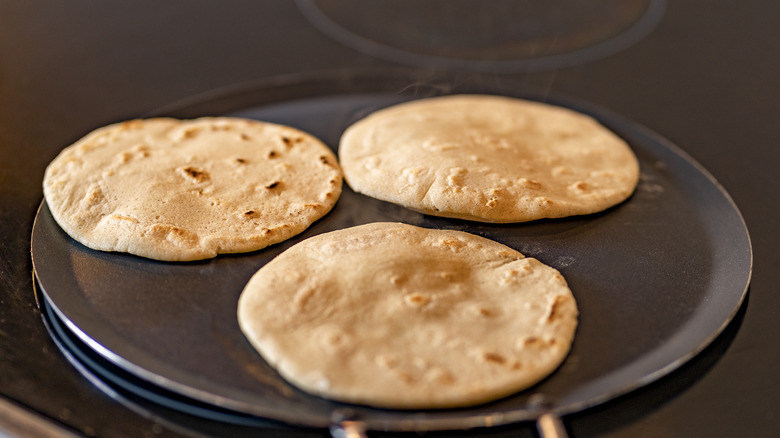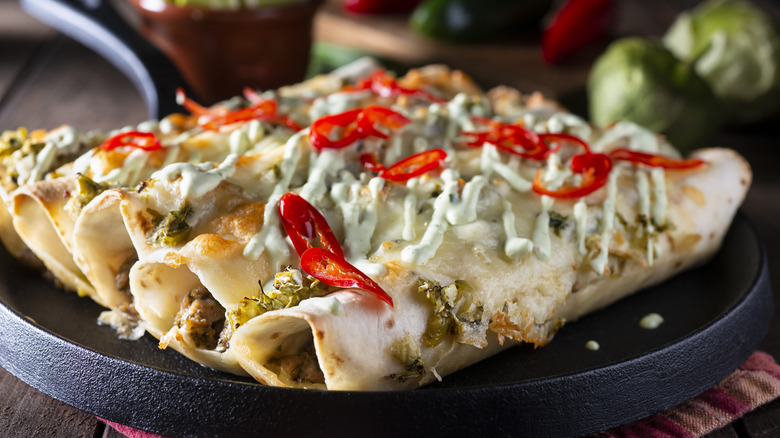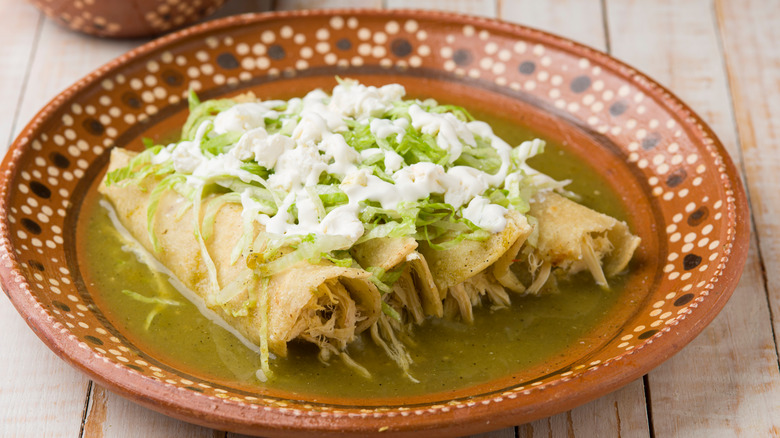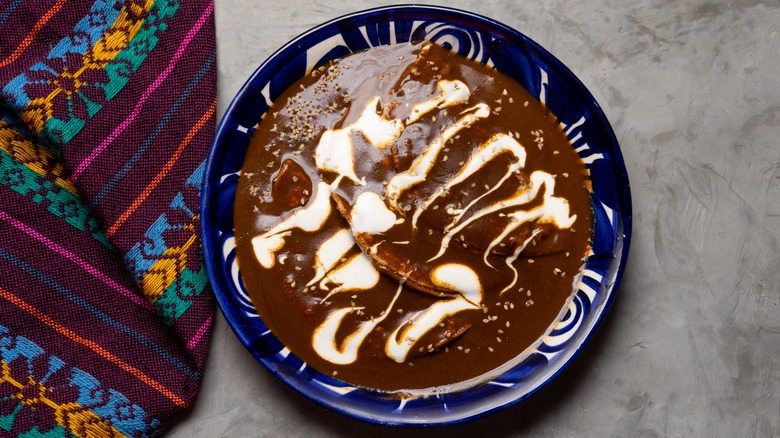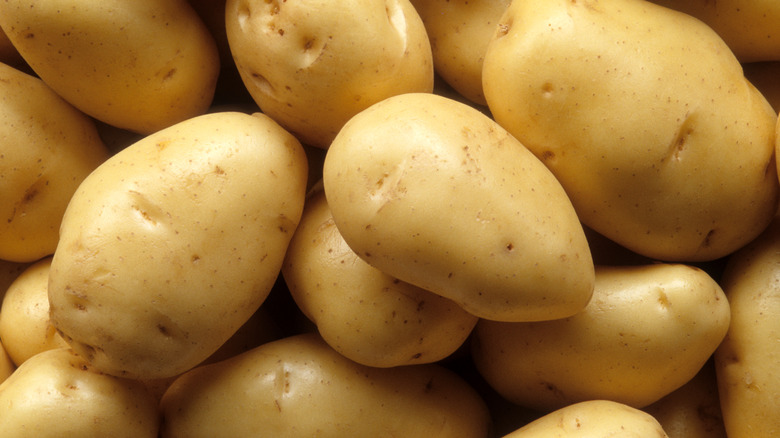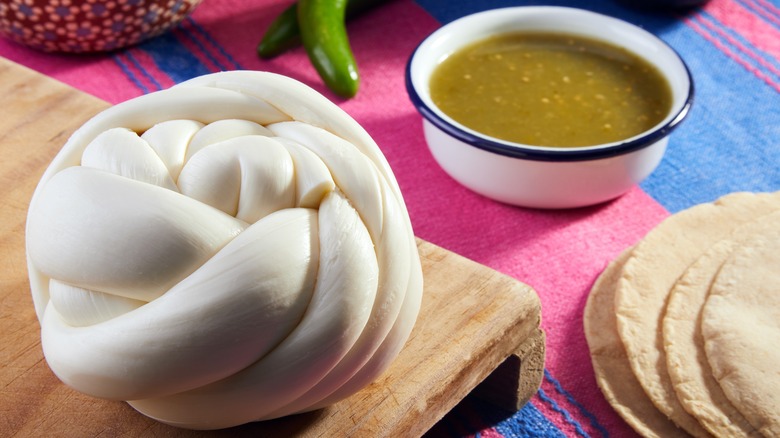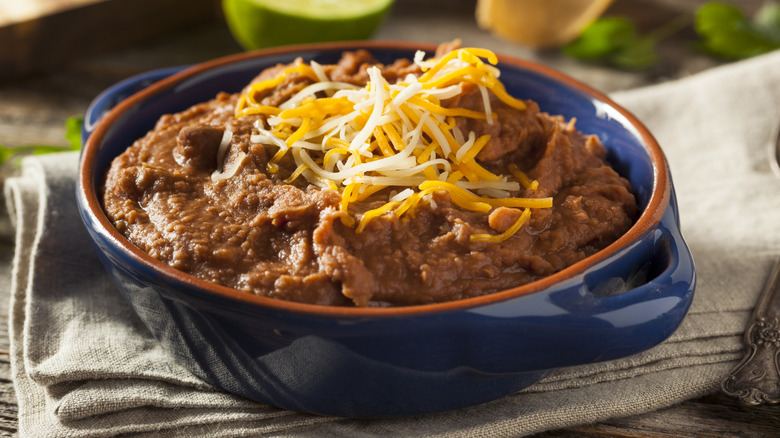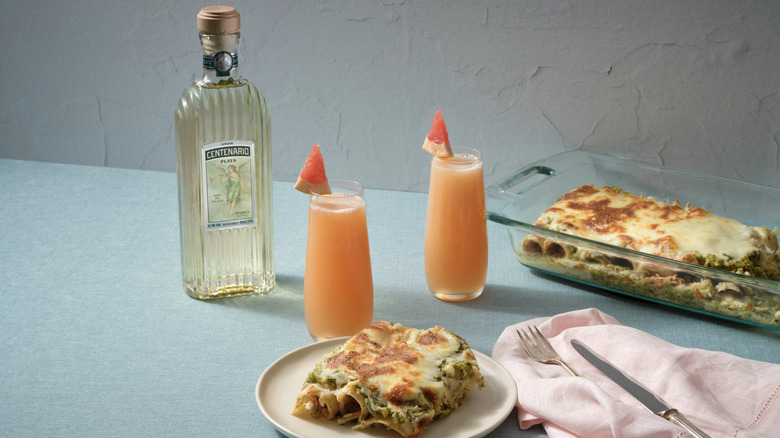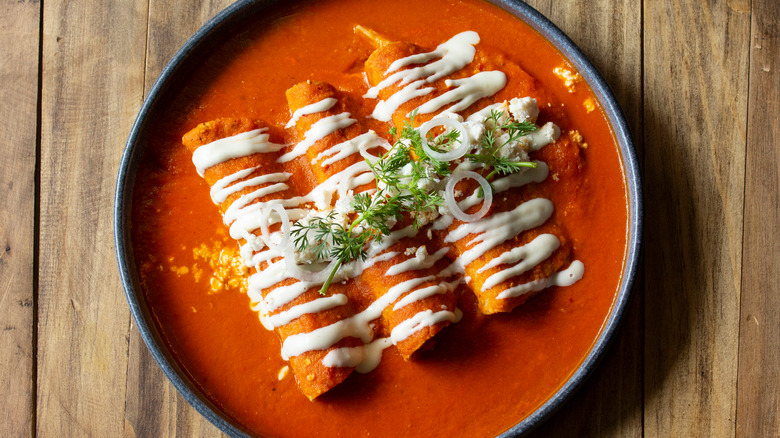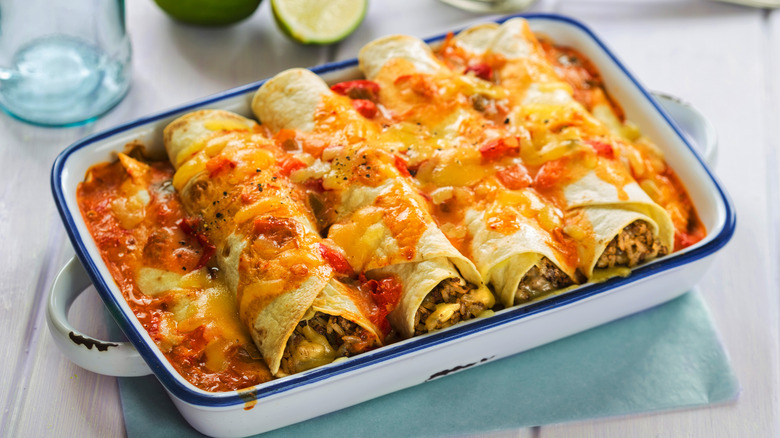Chef Pati Jinich Tells Us Her 13 Best Enchilada Tips And Tricks
Enchiladas are the ultimate party food — nothing wows guests like a colorful tray of filled tortillas coated in a flavorful salsa and embellished with beautiful garnishes. However, whether you're cooking them for guests or just for your own family, you may find it hard to craft enchiladas that look and taste as good as the ones from Mexican restaurants. Perhaps they come out soggy, or the sauce seems bland, or the tortillas fall apart when you try to roll them. If this sounds like you, don't worry; I have all the tips you need to make pro-level enchiladas.
To assemble this list of enchilada tips, I enlisted the help of an enchilada pro. Chef, television host, and cookbook author Pati Jinich is well-known for her PBS cooking show, "Pati's Mexican Table," which has won multiple James Beard Awards. With decades of enchilada-making experience under her belt, the Mexico City native was the perfect person to demystify the dish for us. In an exclusive interview with Tasting Table, she shared her enchilada secrets. Jinich is also an expert at pairing food with tequila — she created a series of recipe videos for Gran Centenario Tequila that show how tequila drinks can elevate classic dishes. In addition to all of her enchilada wisdom, Jinich talked about how to choose the perfect tequila pairings for your next party — whether it's Cinco de Mayo, Mexican Independence Day, or just a random Saturday.
1. Enchiladas don't need a filling
If you walk into any neighborhood Mexican restaurant in the U.S. and order enchiladas, you know what you're going to get: tortillas rolled around a filling, drenched in sauce, and likely covered in cheese. However, in Mexico, the term "enchilada" is used more broadly. As Jinich explained, "enchilada translates to 'something that has been dipped into a sauce with chili.'" Enchiladas can be rolled and filled, or they may be folded or even stacked. The only essential components are tortillas and chile sauce.
Rolled and filled enchiladas are great, but they can be time-consuming and labor-intensive. You have to make a filling, a sauce, and garnishes in addition to taking the time to assemble each enchilada roll. If you want a ton of flavor with less work, make basic, un-filled enchiladas by heating up tortillas, dragging them through some kind of homemade salsa, and serving them with your favorite garnishes. With this style of enchilada, it's important to use great tortillas and to make a super-flavorful sauce, as these components will be highlighted by the simple presentation.
2. Don't use flour tortillas
Jinich told us that "enchiladas are really Mexico's most festive way to honor the tortilla," so choosing the right tortilla is crucial. Since enchiladas are so adaptable, she gave us very few hard-and-fast rules about preparing them, but there was one point that she insisted on: No matter what type of enchiladas you're making, you should always use corn tortillas.
It's not that Jinich is a flour tortilla hater; she loves them for burritos, quesadillas, and certain types of tacos. She just finds that they don't have the right properties for enchiladas. "Corn tortillas are much more malleable, resilient, and hold together better with the sauce and the garnishes and the fillings," she explains. Enchilada recipes typically have a lot of liquid in them, which could lead to flour tortillas dissolving into a gummy, starchy mess. If you're feeling ambitious, you can make your own corn tortillas, but store-bought ones will work just as well if they're prepped the right way.
3. You must heat up the tortillas before assembling
If you do make fresh corn tortillas from scratch for your enchiladas, you can start saucing them and rolling, folding, or stacking them right away with no additional steps. However, if you try assembling enchiladas with cold store-bought tortillas straight from the package, you're setting yourself up for a crumbly disappointment.
Per Jinich, store-bought tortillas must be heated up before you use them in enchiladas. This not only makes them more flexible and less likely to break during the folding process but also helps protect them from absorbing too much liquid from the sauce and fillings. There are two ways to accomplish this; in Jinich's words, you can choose between "dry heat and fry heat." The dry method involves searing tortillas on a skillet, griddle, or comal without oil. Frying, of course, requires dunking each tortilla in a pan of hot oil. For both techniques, you want to see the tortilla puff a bit and brown slightly while remaining soft — if it becomes crispy, you've taken it too far.
Each method has advantages and disadvantages. Dry heating makes less of a mess and results in a lower-calorie dish, but frying waterproofs the tortillas more thoroughly, so the sauce won't make them as soggy.
4. Chiles add flavor, not just heat
As previously discussed, the word "enchilada" refers to coating something in chiles. For that reason, chile peppers are a mandatory ingredient in any enchilada sauce. That might seem like an obstacle if you can't handle hot food, but Jinich explained that chiles don't always have to blow your head off with spice. "They bring different levels of heat, but there are chiles that are sweet. There's like chiles dulces," she added. Chiles dulces, also known as bell peppers, will give you a ton of chile pepper flavor with no heat at all.
That's just scratching the surface of how different types of chiles can be used to fine-tune the flavor of your enchilada sauce. Fresh green chiles will add brightness, mild bitterness, and a bit of vegetal zing. Dried chiles can have a deeply fruity, rich taste. Roasted chiles will bring savoriness and smokiness. Pick your chile varieties carefully to balance the heat levels and the flavor of your sauce, and don't be afraid to mix multiple types to add complexity.
5. Every component of your enchiladas must stand on its own
With a dish that has many components, like enchiladas, it can be tempting to take shortcuts with some of the parts and hope that by combining everything together, you can achieve great flavor. Jinich said that this approach won't work — every piece of your enchilada recipe needs to taste delicious by itself. "If you're making enchiladas and the corn tortillas suck, and the filling is flavorless, and the lettuce that you use was from the fridge from ages ago, and the queso wasn't a good cheese, even if you call it an enchilada and dress it up to the roof, it's not going to be wonderful."
That doesn't mean you can't use hacks to save some time, but it does mean you must make sure to season every layer of the dish. For example, Jinich likes to use leftover rotisserie chicken meat as an easy enchilada filling, but she doesn't just shred the chicken and immediately wrap it in tortillas. She tastes it first and adds salt and spices until it meets her standards.
6. Marry the tastes of your sauce and filling with shared ingredients
Your sauce, filling, etc. don't just have to be well-seasoned; they also have to make sense together. To ensure that the components of your enchiladas all work harmoniously, it's a good idea to add ingredients to the sauce that echo the filling.
Much of the time, this means seasoning your sauce with a broth that matches the protein you're filling your enchilada with. For example, Jinich mentioned that she loves making shrimp enchiladas with a creamy, shrimp broth-infused tomato sauce. "That way, there's no divorce in the dish; the sauce is talking to the shrimp because it's basically shrimp bisque."
With this in mind, it's a good idea to choose proteins that you can use to make both a broth and a filling. Jinich purposefully buys shell-on, head-on shrimp for her shrimp enchiladas because the shells and heads make a great broth. Similarly, if you buy bone-in chicken, you can take the meat off the bones to make a filling and then boil the bones to make chicken stock.
7. Fry your enchilada sauce for a deeper flavor
Many enchilada sauce recipes start by boiling ingredients like tomatillos, tomatoes, onions, garlic, and chiles, then puréeing the cooked veggies with fresh cilantro. Once this step is completed, you might be tempted to call your sauce done — it will look and taste like a finished sauce once it's puréed. However, there's one extra step that will take your sauce to the next level: Heat up a bit of oil in a pan until it's smoking hot, then pour in the puréed sauce and allow it to cook for a couple of minutes. Jinich said that this step, which Mexican cooks call "seasoning the sauce," can make the difference between flat, mediocre enchiladas and a delicious dish.
She explained that by pouring your purée into super-heated oil, "you shock the sauce, and you're forcing the ingredients in the sauce to come and cook together," she said. "You're elevating your sauce to the next step of flavor." Failing to do this can result in a sauce that tastes a bit disjointed and bland.
8. If you don't eat meat, potatoes and greens make a great enchilada filling
Enchiladas are perfect if you're looking for a festive, hearty entrée for meat-free eaters. Simple un-filled enchiladas are an easy vegetarian dish — as long as you don't use meat broth to make your sauce. If you're looking for something more substantial, Jinich recommends using a mix of greens and potatoes as an enchilada filling. The choice of greens is up to you, as long as they're tender — Jinich said that purslane, baby spinach, and watercress are all excellent. The greens give you a lot of bright, fresh flavor, but they won't necessarily fill you up, which is where the potatoes come in. They'll contribute to the stick-to-your-ribs quality that meat-filled enchiladas have.
Greens and potatoes are just some of many plant-based filling options; Jinich mentioned that she enjoys enchiladas stuffed with asparagus spears as well. Feel free to experiment with different veggies, but make sure that they don't have too high a water content, as that will negatively impact the texture of the final dish.
9. Melting cheeses and aged cheeses both have their place in enchiladas
Often the most delectable part of an enchilada platter is the ooey-gooey layer of melted cheese on top. For this, you have many options. One of Jinich's favorites is Oaxaca cheese, a mild, stretchy, mozzarella-like cheese from Mexico. It melts easily and gives you a beautiful cheese pull. She's also a big fan of Chihuahua cheese, which was developed by Mexican Mennonite communities. Like Oaxaca cheese, it has a soft, milky flavor and melts easily, but it's more like Monterey Jack or mild cheddar in taste and texture. If you're having trouble sourcing Mexican cheeses, American varieties like Muenster, Monterey Jack, and mozzarella can be subbed in.
You don't have to limit yourself to just one type of cheese in your enchiladas. All of the melting cheeses we have discussed are relatively bland, so if you want to super-charge the cheese flavor of the dish, garnish it with a crumbly, salty cheese like queso fresco or cotija when it comes out of the oven. Aged cotija makes for a particularly savory topping. Not all styles of enchiladas need a melted cheese layer, either; folded, unfilled enchiladas taste great when simply sprinkled with crumbled cheese to serve.
10. Sides and garnishes bring everything together
While enchiladas can be hearty enough to serve as a meal on their own, it's always more fun to have some side dishes, too, especially if you're making them for a festive occasion like Cinco de Mayo. Jinich likes to stick with tried-and-true classics like refried beans and rice, but she adds some flavorful twists to the beans to make them stand out. First, for people who eat pork, she recommends using lard in refried beans — it gives them a rich, creamy flavor that can't be duplicated. She also likes to amp up her beans with a bit of spice, either from canned chipotles in adobo or cooked jalapeños. In terms of rice, either plain white rice or Mexican red rice will do the trick.
Jinich also told us that serving a contrasting salsa on the side with your enchiladas will make the eating experience more interesting. For example, red salsa or a spicy, oil-based salsa macha can add a different flavor dimension to green enchiladas. By mixing and matching salsas at the table, you can customize each bite and surprise your palate. Similarly, garnishes like fresh avocado, crispy shredded lettuce, and salty crumbled cheese will add a variety of flavors and textures to keep you from getting bored.
11. Think about the flavor of your enchiladas when choosing drink pairings
To really get the party started, you'll want to pair your enchiladas with tequila drinks. Jinich likes to change the mixers and the variety of tequila depending on what type of enchiladas she's serving. For example, with brunch enchiladas, she'll go with a tequila-spiked mimosa. For lunch, she likes a charro negro, which is tequila with Coke, lime juice or lemonade, and an optional lime popsicle. If versatility is what you're looking for, margaritas go well with a meal at any time of day.
Jinich's favorite all-purpose tequila is Gran Centenario Plata, a smooth, mellow blanco tequila that works well as a mixer because of its mild, sweet taste. Sometimes, however, certain dishes call for a bolder flavor. She mentioned that she enjoys pairing red meat dishes like birria with reposado or añejo tequilas, which are aged and have a fuller flavor than blancos. You might consider an añejo for something like red chile beef enchiladas, as it will complement the intense taste of the beef.
12. Don't forget about brunch enchiladas
Enchiladas are commonly thought of as a lunch or dinner food, but Jinich thinks they can be a great breakfast food, as well. Her brunch enchiladas are stuffed with scallion-studded scrambled eggs and topped with a sauce of seasoned, puréed black beans. The dish is garnished with crumbled chorizo, avocados, cheese, and pickled jalapeños. It's a great way to make brunch for a crowd, and it's an excellent example of how Jinich likes to use shared ingredients in multiple components of the same enchilada recipe — in addition to garnishing with pickled jalapeños, she also seasons the black bean sauce with the jalapeño pickling liquid.
If you like the idea of brunch enchiladas but don't want to follow Jinich's exact recipe, there's plenty of room to experiment — just roll your favorite breakfast ingredients into enchiladas. Bacon-and-egg-filled enchiladas covered with cheese sauce would be excellent, for example. Most ingredients that would work in a breakfast taco or burrito could work in enchilada form.
13. Enchiladas reheat well, but save the garnishes for the last minute
If you're hosting a big Cinco de Mayo party, you may want to make enchiladas ahead of time so you can reheat them on the day of the celebration and spend time with your guests instead of running around the kitchen. Jinich said that there are a couple of great ways to pre-prep enchiladas. First, you can make your filling and sauce ahead of time, reheat them, and assemble the enchiladas the day-of. You can even prep garnishes like crumbled cheese and shredded lettuce a day or two before your guests arrive. Second, if you really want to save time, you can choose a casserole-style enchilada recipe and assemble the whole thing in a baking dish before the party. Simply reheat the whole pan in the oven when you're ready to eat.
Regardless of what reheating method you choose, don't add your garnishes to the enchiladas until you're at the table and ready to eat. Fresh garnishes like shredded lettuce, sliced avocado, and herbs won't fare well during the reheating process.
Jinich also mentioned that you can make your life easier by pre-prepping your cocktails in addition to your enchiladas. "You can have your margarita mix in the fridge and have it chilled and then just rim your glasses when your guests come over," she said. With cocktails and enchiladas out of the way, you can set yourself up for a seamless hosting experience.
